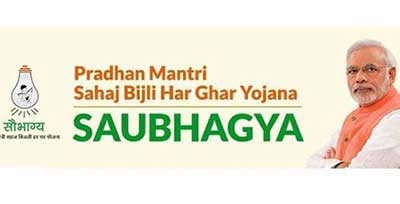Relevance: GS-3: Indian Economy and issues relating to planning, mobilization, of resources, growth, development and Inclusive growth and issues arising from it
Key Phrases: Universal Household Electrification, Pradhan Mantri Sahaj Bijli Har Ghar Yojana – ‘Saubhagya’ scheme, ‘Sankhya’ Portal, Cooperative Federalism, ‘Saubhagya Raths’
Context:
- Recently, the government of India converged its focus more on Universal Household Electrification by aspiring to electrify all households in the country.
- Earlier, the government launched the Pradhan Mantri Sahaj Bijli Har Ghar Yojana – ‘Saubhagya’ scheme,calling upon all stakeholders to channelize their energies towards electrification of each and every household in the country.
- Recently in an address PM said that SAUBHAGYA is the story of a nation’s success journey. A journey that transformed the lives of millions of Indians. A challenge of epic proportions which was achieved by a nation in just a few months – bringing to life the world’s largest household electrification drive.
About Saubhagya Scheme:
- The Government of India launched ‘Pradhan Mantri Sahaj Bijli Har Ghar Yojana’ (Saubhagya) in Sept. 2017 to achieve the goal of universal household electrification in the country by 31st March 2019.
- The scheme envisages to provide last mile connectivity and electricity connections to all remaining households in rural as well as urban areas.
- The Government with the support of State Power Departments and DISCOMs have already connected about 3 Crore households since the launch of the scheme.
Why is Electrification Needed ?
- Electrification opens up a world of opportunities - it empowers citizens and transforms their quality of lives.
- Provides extended working hours for small and emerging businesses.
- Improved health conditions in health and wellness centers.
- Learning opportunities for children across geographic zones.
- Enhanced security solutions for communities in both urban and rural areas.
- Electrification brings with it renewed hope for a brighter and more sustainable future.
Assessments of SAUBHAGYA Scheme by Editorial:
- Identification challenge:
- From the beginning, the government has faced the challenge of identifying unelectrified households of the country.
- Pragmatic in approach – the government used a more than 150 year old backbone of our country’s communication network; the department of posts.
- A survey was conducted through posts for firming up the number of unelectrified households.
- Use of Technology:
- ‘Sankhya’, a Web Portal and Mobile App, was specifically developed for identification surveys for real time analysis and for formulating a prudent strategy.
- Boost to Cooperative Federalism:
- Implementation of SAUBHAGYA is a remarkable success story of Cooperative Federalism where both the State and Central Governments worked with seamless coordination for timely achievement of targets.
- 56 DISCOMs worked tirelessly across the length and breadth of the country to ensure electricity connections to every willing household.
- Saubhagya camps were organised at village level to reach out to the beneficiaries and to facilitate on the spot electricity connections – ensuring that no household was left out.
- Campaigned as 'Jan Andolan' with people's participation:
- A special fleet of ‘Saubhagya Raths’ were flagged off across various states in the country to create awareness among the people.
- It identifies every household without electricity because they might have failed to register under the scheme initially.
- Good governance in implementing the scheme:
- A Control Room that worked 24x7 was set up to assist the beneficiaries on all scheme related queries, address their grievances and also provide electricity connections with the support of DISCOM for speedy resolution.
- In locations where the solutions were not techno-economically viable due to scattered households, stand-alone Solar PV-based systems were installed.
What are the suggestions provided in the Editorial for 24×7 power for all?
- India needs real-time monitoring of supply at the end-user level: India currently has no provision to monitor supply as experienced by households. Smart meters (that the government plans to roll out) should help enable such monitoring.
- DISCOMS need to focus on improving the quality of supply as well as maintenance services. DISCOMS need to identify novel cost-effective approaches to maintain infrastructure in far-flung areas.
- Learn from best practices:
- Odisha has outsourced infrastructure maintenance in some of its rural areas to private franchisees, which are working more effectively.
- Maharashtra has introduced village-level coordinators to address local-level challenges immediately so that no delay in approval.
Way Forward:
- After the electrification of 2.82 crore willing households, the Government is now working towards providing reliable quality 24 x 7 power supply in urban and rural India.
- An uninterrupted supply of electricity to every Indian household would mean improved access to all necessities.
- Mainly, a major transformation in rural areas— As more and more citizens will be able to utilize new and improved agriculture techniques, agro-machinery, latest technologies etc. leading to a significant increase in agricultural production, thereby improving economic growth.
- Reliable power will also bring with it ample opportunities in various small-scale industries with the setting up of new businesses and facilitating socio-economic growth and development.
- As India steps into a new era of progress, not a single citizen shall be left behind as we achieve our goal of ‘POWER FOR ALL’.
Source: The Hindu BL
Mains Question:
Q. Every household electrification has become necessary to realize the vision of 'Power for all by 2022' . In this context, critically evaluate how the successful implementation of the SAUBHAGYA Scheme could be a great milestone in this direction. (15 marks).









